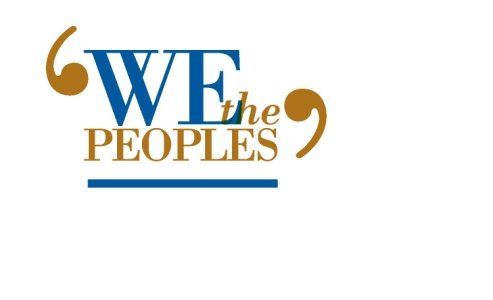Chapter 1
What Is Socialutions?
The social web represents
people interacting, seeking
and finding solutions to
problems, information, and
career opportunities in a new
organized structure. The
fluidity and dynamics of this
structure change all the old
rules and paradigms of
problem solving.
To understand this new
dynamic, we must define it
using a combination of words
from our established
dictionary.
The Wiktionary defines the
term “solution” as:
1. An act, plan or other means, used or proposed, to solve a problem.
2. The act or process of explaining or proposing an approach to solving a problem. (business)
3. A homogeneous mixture, which may be liquid, gas or solid, formed by dissolving one or more substances. (chemistry) 4. The answer to a problem. (mathematics)
5. Satisfaction of a claim or debt. (law)
The word social has come to mean many things but the basic definition is:
1. Characterized by, or inclined to living together in communities 2. Of or relating to the structure, organization, or functioning of society.
3. Something worked out to explain, resolve, or provide a method for dealing with and settling a problem.
We have coined a new word, “Socialutions” and defined it as people, communities and organizations leveraging technology to interact with people for the purpose of solving problems; the act of working together with others to create new solutions to old paradigms of communications and interaction without boundaries and with limitless reach.
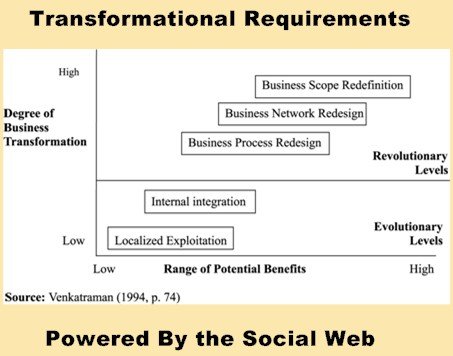
This definition best defines the new paradigm of problem solving and finding innovative solutions through social exchanges. Socialutions redefines organizational and institutional methods used previously to manage people and groups as well as customers and suppliers.
When a new method or paradigm is introduced, the old methods and mindsets must be thrown out in order for the new method to be truly optimized. Optimization of knowledge comes from the collaboration of many, and wisdom can come from the crowds or swarms. Yesterday’ss solutions to customer service, product development, human resource management and a host of other traditional organizational processes are being turned upside down and inside out.
For those who are currently using pre-social media management methodologies, in order to adapt and flourish in the new paradigm they must understand the dynamics, the tools, and the methods of Socialutions.
Otherwise, any attempts to leverage the new paradigm by forcing it to fit into old methods will create social rejections and the old problems will remain.
Further, the results will be worse than previously experienced because people do not want to be tricked into something that is not real, social, and involves them in finding solutions.
Companies must begin to apply Socialutions to their existing and future problems before the problems become social and public relations nightmares.
Socialutions is about uniting relations aimed at a common purpose. United Relations, found at http://www.linktounitedrelations.org, promotes this concept and is a movement for users to organize and set the agenda for the future of the web.
Socialutions: A Process, Product or Philosophy?
Socialutions is a shift in thinking for people and organizations. The shift is enabled by the knowledge of what drives the social dynamics of today’s web of relations.
The new knowledge
transcends thinking much as
“the Quality Movement” of
the eighties, transcends in
that is neither a product nor
process (although processes
are involved). Rather it is a
philosophy of a new
management paradigm. The
new management paradigm
labeled “Socialutions”
includes:
1. Tapping into the organization’s greatest resource: people (employees, customers & suppliers) for innovation, problem solving and breakthrough ideas.
2. Engaging in open and honest conversations without corporate spin or adherence to past policies.
3. Enabling customers and suppliers to assist in the rapid improvement of the organization’s feedback loops.
4. Changing from spin marketing to conversational marketing.
5. Removing corporate barriers to honest and open conversations i.e., power and political barriers.
6. Leveraging “free” technology to improve processes, products and communications.
7. Responding time to issues and critical conversations is targeted at the immediate.
8. Finding ways to leverage social media that breaks down barriers and reduces cost forever.
9. Learning how to listen to the voice of the people repeatedly.
Education becomes a constant—a must.
10. Leading the transformation of your culture and asking everyone to engage in the process, from the top to the bottom, inside and out.
The converging dynamics of open conversations and technological breakthroughs will transform markets at the click of a mouse. If your business cannot see that the train is coming, then it just may be sitting on the track looking in the wrong direction. At some point your organization may be surprised as to how fast it is losing customers to either an existing or new company that has embraced the transformation before you.
There is a lot more to learn but even more to forget. Socialutions is a transformation of mind and heart for businesses and their relationships with people. Transformation is everyone’s job but leaders have to agree that things need to change.
Six P’s + Leadership = Socialutions
Businesses are just now beginning to examine the power of the social web for business purposes. However, most approach it as a marketing mechanism rather than as a movement that requires a new management model if organizations are truly going to optimize Socialutions.
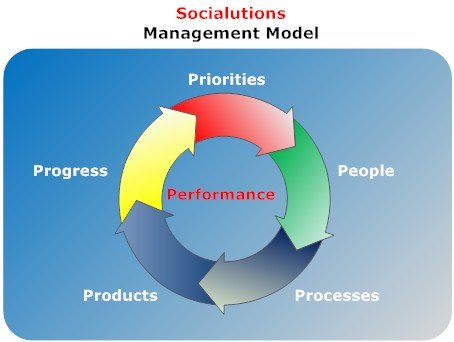
.
Management practices and
theories have changed
overtime as markets have
matured and pressures for
performance have
increased exponentially.
From the Industrial Era to
the Information and
Knowledge Era,
organizations have had to
adjust their management
methods to survive and
compete. Now we enter
into the “Social Era” and
again management methods and theories must change to survive with the globalization of markets and interactions with people.
We have examined the required changes in methods, models and mindsets and identified the six P’s of the next shift in organizational design required to prosper and perform during the emerging Social Era. The Social Era is defined as a shift in management methods that are: 1. Characterized by, or inclined to working together in organizations and communities.
2. Of or relating to the structure, organization, or functioning of the organization as a social organism.
3. Something worked out to explain, resolve, or provide a method for dealing with and settling a problem of performance and progress.
Socialutions is a management method driven by six P’s which are: 1. Priorities: Leadership’s responsibility is to set the priorities based on feedback loops from markets, people (suppliers, employees & customers) and the markets the organization serves.
2. People: The greatest asset of any organization is the people--people given the tools and the freedom to create solutions that enable the organization to move progressively towards its vision, it customers, and its markets.
3. Process: Organizations need processes, but many times processes restrict the organization. People empowered to remove or change processes with the aim at better serving the customer, internal and external, should be the primary process of importance. If policies and processes are in the way of progress, let the people remove them.
4. Products: Whether manufacturing a hard product or delivering soft services, the people and processes produce products.
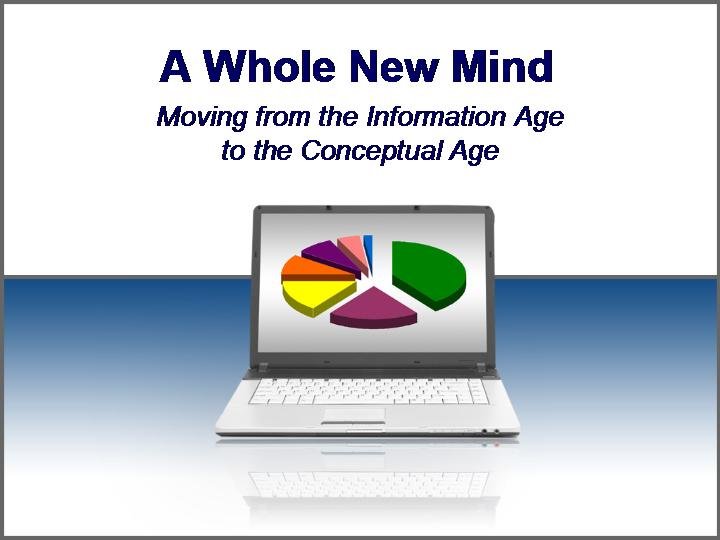
5. Progress: Unless customers, both internal and external, are able to achieve progress then whatever your organization has produced is a waste of time and effort to the end user and their need to make progress as they define it, both internally and externally.
6. Performance: Bottom-line results are a measure of income and profit for shareholders. In order to improve performance during the Social Era the emphasis must be placed on never ending changing improvement of the previous five P’s. Leading and managing performance starts with step 1 and ends with step 5--which produces step 6.
The driving factors of the Social Era will be technology, education, adaption and speed. Organizations will win or lose employees, customers, suppliers and markets based on their effective or ineffective adoption of Socialutions as the management method for the future.
Socialutions: Is It Disruptive Innovation?
The web is exploding with
innovation, and businesses
are racing to define ways to
monetize the new markets
created by innovation.
However, chasing the
innovations does not always
equate to capturing the
value chain and creating
new revenue streams.
Innosight reports “Twenty-
five percent of all new
products that established
companies introduce in their markets succeed. Seventy-five percent fail. Ten percent of companies can maintain a level of growth which satisfies their shareholders over the long term. Ninety percent cannot.”
“Most of those companies seem to be doing the right things — listening to their best customers, keeping a close eye on competitors, and investing heavily in technological advancements. Long-term success requires more. It requires that companies develop strategies around disruptive innovation.” Companies that unleash the power of disruptive innovation can create booming growth businesses, but what exactly is “ disruptive innovation”?
“The disruptive innovation model explains how companies can create new growth by delivering relatively simple, convenient, low-cost innovations to consumers who are overshot by existing offerings or who are locked out of a market due to a lack of skills, wealth, access or time. These consumers are delighted with “good enough” products that enable them to solve an important problem they could not adequately solve before, at a price point that is palatable.”
Why Some Can and Some Cannot
It is safe to say that today’s web is disruptive, but turning disruption into revenue takes more than innovation. Most of today’s disruptive technologies are being fueled by small organizations made up of youthful minds, and the culture of these organizations is not conducive to historical “corporate cultures.” The “disruptive” organization is a social organization whose creativity facilitates solutions and capabilities never before imagined and fueled by the social web. What makes Facebook grow? Is it due to the independent application developers or the users or the very “social utility” created by collective culture of the Facebook Economy? None of these dynamics is traditional to the typical corporate mindset.
We are witnessing the impact of a Social Era on business design and management, and the new business models are able to capture and quickly turn innovation into revenue. The new model is one of “Socialutions,” it is in of itself a “disruptive innovation” that changes the way businesses are run, and innovation is captured.
In the Business Week article titled How Google Fuels Its Idea Factory: CEO
Eric Schmidt describes the simple principles driving the company’s steady stream of innovations.
“Can other companies emulate Google’s famous model of letting
engineers spend about 20% of their time on projects outside their
main job?”
“The story of innovation has not changed. It has always been a small team of people who have a new idea, typically not understood by people around them and their executives. [This is] a systematic way of making sure a middle manager does not eliminate that innovation. If you’re the employee and I’m the manager, and I sit down and say, “Our product’s late, and you screwed up, and you gotta work on this really hard,” you can legally say to me, “I will give you everything I’ve got, 80% of [my time].” It means the managers can’t screw around with the employees beyond some limit. I believe that this innovation escape-valve model is applicable to essentially every business that has technology as a component.”
“Why are not many other companies doing this, too?”
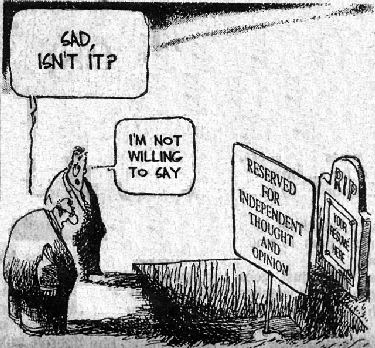
I think it’s (sic) cultural. You have to have the culture, and you have to get it right.” ”
Sounds like Google lives Socialutions.
How Do You Infect Minds?
In the physical world, infections are usually a reference to our bodies. In the virtual world, the term ‘infections’ usually carries a connotation of viruses infecting our machines. However, there is another dimension of infection and that is in reference to our minds.
If you can infect a mind, you can control the body.
An infection of our minds
is the colonization of our
thoughts by the thoughts
and words of others. In an
infection, the infecting
thoughts and words from
others seek to utilize our
resources to multiply. The
infecting words interact
with the normal thinking
of our minds and can lead
to a “viral infection”
when we pass the
thoughts and words on to
others.
A “secondary viral
infection” is an infection
that occurs during or
following reaction to our
thoughts, ideas and words originated by our primary infection. The infection of ideas, perspectives, news and commentary spreads to “swarms and hives” of communities who mass the infection according to Metcalf’s Law.
Which Viral Infections Have the Greatest Impact on Our Minds?
Based on some rudimentary analysis, we find the following categories of viral infection:
1. Breaking News: Grabbing the readers’ attention about technological developments, movers and shakers, etc. This creates a short tem infection.
2. Perspectives: Peoples’ ideas, opinions and perspective on the emerging virtual world and its meaning. The spread of this infection depends on the rationale and sound thinking behind the perspectives.
3. Personality: An individual, groups of individuals or communities that infect others by creating attraction through personality, much like celebrities.
4. Thought Leaders: Those individuals or firms who publish research or share insights into the future of the virtual world.
5. Market Makers: Those individuals or organizations that create new and useful functionality and features to the virtual world experience.
Now think about what and whom you follow on the web. Which category of
“infection” is it that affects your mind the most? The game is to decide whether you can create an infection or if you are being infected. Now imagine if we could organize our virtual world by uniting relations around the categories of infection. In essence our collective ability to infect entire markets could be profound, but not until and unless we organize our efforts.
That is why we are suggesting that we unite our relations using the United Relations social media platform at http://www.linktounitedrelations.org.
Rather than being infected, we, the users, can infect the markets with more influence.
Cultural Socialutions – Oxymoron or Logical Thought Process?
The marketplace is buzzing with the new way of solving problems.
We previously defined Socialutions as people, communities and organizations leveraging technology to interact with people for the purpose of solving problems; the act of working together with others to create new solutions to old paradigms of communications and interaction without boundaries and with limitless reach.
The irony of starting with a definition lies in our use of contemporary tools. In order to provide an easy way to use their product for more searches, Google™ has a relatively simple code that allows us to type in “define: the word you want to define.” Entering the words “define: socialutions” you are asked “Did you mean to search for: " define associations?" Note that Google™, as they often do, tries to be helpful when they find nothing based on your typing . . . and they relate socialutions with associations!
So how is Associations defined? Dictionary.com has a head start when they define association as: “An organized body of people who have an interest, activity, or purpose in common.” Coincidentally, that is exactly what it will take to implement solutions . . . an organized body that has interests and purposes in common.
Does that define today’s organizations?
In the proposed definition, we identify the need for organizations working together with others to create new solutions. What could possibly stop this collaboration from happening? Personal agendas, political grievances, a lack of agreement . . . all wrapped up in the culture of the organization are what can stop progress and innovation!
Why is the culture a problem when it comes to implementing socialutions?
Inherent in the suggestion that a solution is in order is the implication that there is a problem. Most of us, organizational leadership included, want to hear anything but that culture is the problem. The existence of a problem rarely means that everything has been done well. It often means someone has missed something, and that someone may be us or someone who works for us. Usually, problems mean added costs, and that is rarely considered good. However, socialutions does not need to indicate the existence of a problem.
Socialutions can be used to define a paradigm of problem solving and finding innovative solutions through social exchanges. Envision a Corporate Socialution!
Many leaders understand the problem solving part; it is the innovation part with which they have difficulty. As has been noted already, the paradigm means: Engaging the organization’s employees, customers and suppliers for innovation, problem solving and breakthrough ideas, changing the marketing focus, removing barriers, and leveraging technology and social media to increase response time by listening and learning. The result can only be a changed paradigm, with a cultural transformation where everyone is engaged.
References
Associations. (2008). Retrieved May 4, 2008, from http://dictionary.reference.com/browse/associations Innosight (2008). Retrieved May 3, 2008, from http://www.innosight.com/innovation_resources/diagnostic_tools.html and The Innovator’s Solution (Harvard Business Press, 2003, pp 4-5) Metcalf’s Law. (2008). Retrieved May 4, 2008, from http://en.wikipedia.org/wiki/Metcalfe%27s_law Nance/Redux, A. (2008, April 29). How Google Fuels Its Idea Factory.
BusinessWeek. Retrieved May 3, 2008 from http://www.businessweek.com/magazine/content/08_19/b4083054277984.h tm
Solution. (2008). Retrieved April 30, 2008, from http://en.wiktionary.org/wiki/solution
Venkatraman 1994] Venkatraman, N.: IT-Enabled Business Transformation: From Automation to Business Scope Redefinition, Sloan Management Review, Vol. 35, Nr. 2, p. 73ff., 1994
